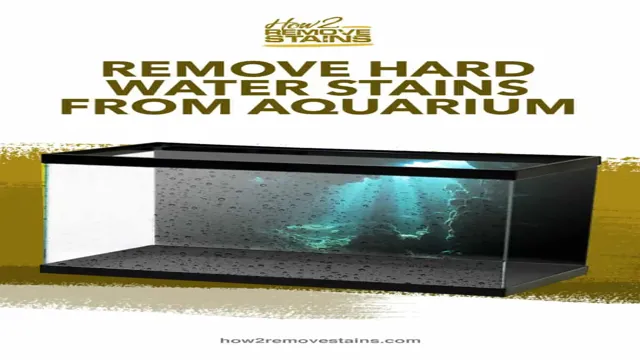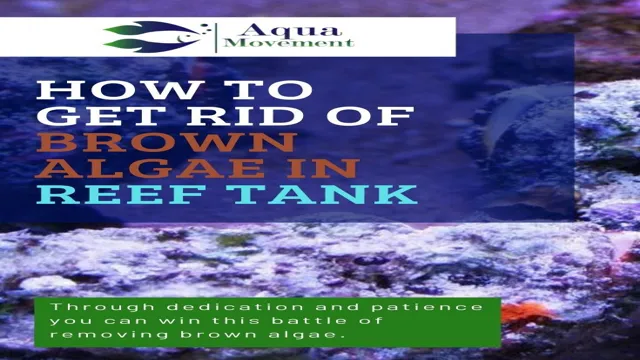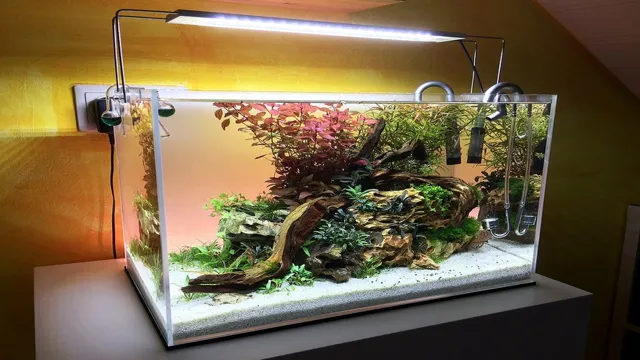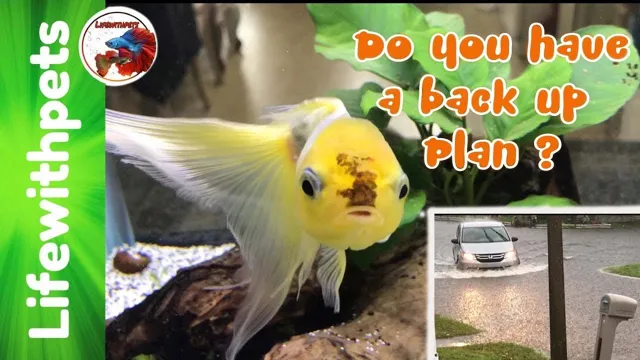How to Get Hard Water Off Aquarium: Tips and Tricks for Crystal Clear Fish Tanks

Are you tired of your once crystal clear aquarium looking cloudy and stained from hard water? Hard water stains can be a real eyesore in aquariums and can make it difficult to see your fish and other aquatic life. Luckily, removing hard water stains from your aquarium is a simple process that can restore your tank’s clarity. In this article, we will dive into the various ways you can remove hard water stains from your aquarium.
From vinegar and baking soda to commercial products, we will explore the most effective methods to make your aquarium sparkle once again. So, grab your cleaning supplies, and let’s get to work!
Understanding the Problem
Dealing with hard water on an aquarium can be a difficult and frustrating issue for any aquatic pet owner. The buildup of minerals and sediment can occur on glass and decorative elements in the tank, leading to unappealing and unsanitary conditions for your fish. One of the easiest ways to tackle this problem is by using a specially formulated aquarium glass cleaner that can dissolve the hard water deposits in minutes.
For tough stains and buildup, it may be necessary to use a razor blade to scrape the glass. Additionally, replacing hard water with distilled water or reverse osmosis (R.O.
) water can prevent the buildup from happening in the first place. By regularly cleaning and maintaining your aquarium, you can prevent hard water accumulation and create a healthy environment for your aquatic pets to thrive.
What Causes Hard Water?
Hard water is caused by high levels of dissolved minerals, such as calcium and magnesium, in the water supply. These minerals are picked up as the water travels through rocks and soil on its way to our homes. While hard water is not harmful to our health, it can cause a range of issues around the house.
For example, it can leave unsightly stains on surfaces and appliances, such as sinks and kettles. It can also build up in pipes, leading to decreased water pressure and blockages. Furthermore, hard water can make soaps and detergents less effective, leading to increased water consumption and higher energy bills.
To address these problems, many homeowners invest in water softening systems, which remove the excess minerals and improve the overall quality of their water supply.

Why is Hard Water Bad for Your Aquarium?
Hard water can be harmful to your aquarium and its inhabitants due to its high mineral content. When tap water is considered “hard,” it means it contains high levels of calcium and magnesium, which can cause a variety of problems in your aquatic environment. These minerals can cause your aquarium’s pH levels to increase, which can be stressful or even deadly for certain fish and plants.
Additionally, hard water can lead to unsightly buildup on tank surfaces and equipment, leading to potential damage or maintenance issues. It’s important to regularly test your aquarium’s water quality and take steps to mitigate any issues caused by hard water to ensure the health and longevity of your aquatic pets.
Cleaning Methods
If you own an aquarium, you know how important it is to keep it clean and free of hard water stains. So, how do you remove those stubborn marks from your tank? One of the most effective methods is using white vinegar. To do this, mix equal parts water and vinegar and apply it to the affected area with a soft cloth.
Leave it on for a few minutes and then scrub the area with the cloth until the stain is removed. Another option is using a commercial aquarium stain remover. Be sure to read the instructions carefully and follow all safety precautions.
When cleaning your aquarium, always use a gentle touch to avoid scratching the glass. Remember to keep up with regular cleanings to prevent hard water buildup in the first place. By using these methods, you can keep your aquarium looking its best and your fish happy and healthy.
Method 1: Vinegar Solution
If you’re looking for a natural, eco-friendly way to clean your windows, then the vinegar solution method might just be what you need. Vinegar is a fantastic natural cleaner that’s both environmentally friendly and effective at removing dirt and grime from glass surfaces. To create a vinegar solution, all you need to do is mix equal parts of vinegar and water in a spray bottle.
Make sure to shake well before use, and then simply spray the solution onto your windows and wipe away with a clean cloth. The great thing about this method is that it’s simple, affordable, and there’s no need for any harsh chemicals. Plus, vinegar is readily available in most grocery stores, making it a convenient choice for those looking to clean their windows in a more sustainable way.
Method 2: Citric Acid Solution
If you want to clean your coffee maker without using harsh chemicals, citric acid might be the solution for you. This method is not only safe but also effective in removing mineral buildup in your coffee maker. To start, mix 1 cup of hot water with 1 tablespoon of citric acid and stir until the acid is fully dissolved.
Pour the solution into the water reservoir of your coffee maker and turn it on as if you were making coffee. The citric acid solution will run through the coffee maker and dissolve the mineral buildup. Once the cycle is finished, rinse the coffee maker with clean water, and your coffee maker will be ready to use again.
Citric acid is not only a great alternative to harsh chemicals but also a natural option that is safe for you and the environment. Give it a try and enjoy a freshly brewed cup of coffee!
Method 3: Bleach Solution
If you’re searching for a potent cleaning solution to wipe out the germs and bacteria from your home, the bleach solution can be a fantastic option for you. Bleach is a robust sanitizer that contains active ingredients that can kill germs, bacteria, viruses, and fungi promptly. To prepare this powerful solution, you need to add one tablespoon of bleach in one gallon of water.
Take a sponge or cloth and dip it in the solution, and then clean your surfaces thoroughly. However, before utilizing bleach to clean your surroundings, ensure to read the instructions given on the label. It’s crucial to know the right ratio of bleach and water to use to sanitize your house.
Additionally, it’s important to use gloves while cleaning with bleach and keep the room well ventilated. Bleach is an effective cleaning solution that can make your surfaces germ-free, but use it carefully, as it can be harmful if not used properly.
Prevention Tips
If you have hard water in your aquarium, it can be a real pain to get rid of. The mineral build-up can damage your aquatic plants and even harm your fish. Fortunately, there are some great preventative measures you can take to keep your water clean and soft.
First, make sure to test your water regularly and adjust your pH levels as needed. Second, consider using a water softener to help remove excess minerals from your tap water. Finally, use a good quality filter to keep your aquarium water clean and clear.
By taking these steps, you can keep your aquarium looking great and your fish happy and healthy. And if you do notice any mineral build-up in your tank, try using a gentle scrub brush or specialized cleaning solution to remove it without damaging your delicate aquatic ecosystem.
Regular Water Changes
One of the most essential components of maintaining a healthy aquarium is performing regular water changes. These changes help to remove excess waste, toxins, and other harmful substances that can accumulate in the water over time. To ensure that your aquarium stays clean and healthy, it’s essential to implement a consistent water change schedule.
One of the best prevention tips is to clean your aquarium regularly by changing the water frequently. This will help prevent the buildup of harmful chemicals and bacteria in the water, and it will also help to keep your fish and other aquatic creatures healthy. A recommended frequency for water changes is once a week, but this can vary depending on the size of your aquarium and the number of aquatic creatures living in it.
By performing regular water changes, you can help ensure that your aquarium stays clean, healthy, and vibrant for years to come.
Use a Water Softener
If you’re experiencing hard water in your home, you might want to consider using a water softener as a prevention tip. A water softener can significantly reduce the amount of mineral buildup in your plumbing system. This buildup can cause plumbing issues and can even damage your appliances over time.
By using a water softener, you’ll not only prevent future issues, but also extend the lifespan of your appliances. The process involves removing the excess minerals present in the water supply, such as calcium and magnesium ions, which cause hard water. This will leave you with softer and more manageable water that feels better on your skin and hair.
By investing in a high-quality water softener, you can enjoy all the benefits of soft water without any of the downsides. So if you’re tired of dealing with hard water and the resulting plumbing problems, a water softener might just be the solution you need.
Final Thoughts
In conclusion, getting rid of hard water buildup in your aquarium can be a daunting task, but it is essential to keep your fish tank healthy and thriving. Regular water changes can prevent hard water buildup, but it is not always enough. Simple tips like using vinegar and bleach can easily dissolve hard water stains and leave your aquarium looking pristine.
However, it is crucial to remember to rinse thoroughly and not to use too much of these products, as they can harm your aquatic friends. If you are struggling with hard water buildup, consider investing in a water softener or using RO/DI water for your aquarium. Remember to always test the water quality and make necessary adjustments to ensure your fish have a comfortable and safe home.
By following these steps, you can enjoy a beautifully clear and healthy aquarium for years to come.
Conclusion
Well, after much research and experimentation, it seems that the best way to get hard water off your aquarium is by using a mix of equal parts vinegar and water. But let’s be real, no matter what method you choose, dealing with hard water is a real pane in the glass. So next time you’re considering installing a new aquarium, remember – hard water can be a tough opponent, but with a little elbow grease and some clever tricks, you can keep your aquatic pets swimming happily and your tank shining brightly.
“
FAQs
What causes hard water in an aquarium?
Hard water in an aquarium is caused by high levels of dissolved minerals such as calcium and magnesium.
How does hard water affect aquarium plants and fish?
Hard water can make it more difficult for plants to absorb nutrients and can also stress fish by affecting their gills and overall health.
What are some signs that an aquarium has hard water?
Signs of hard water can include white deposits on aquarium surfaces, cloudy water, and poor plant growth.
Can adding chemicals or treatments help reduce hard water in an aquarium?
Yes, there are products available that can help reduce hard water levels in an aquarium, such as water conditioners or ion exchange resins.
How often should the water in an aquarium be tested for hardness?
Water hardness should be monitored regularly, with testing recommended at least once a month.
What are some natural ways to reduce hard water levels in an aquarium?
Adding certain types of plants or driftwood to the aquarium can help naturally reduce hard water levels over time.
How can hard water deposits be removed from aquarium surfaces?
Vinegar or citric acid solutions can be used to remove hard water deposits from aquarium surfaces, but it’s important to thoroughly rinse the surfaces afterward to avoid any harm to fish or plants.






